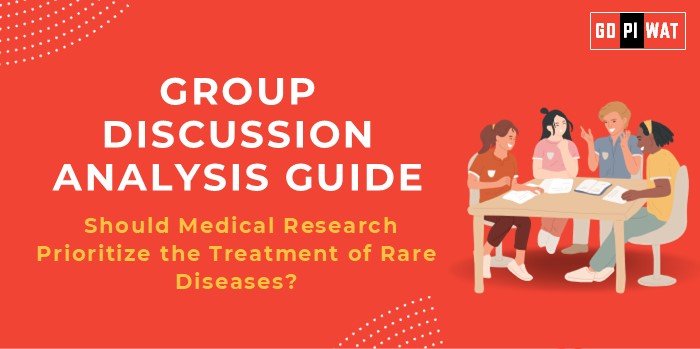📋 Group Discussion (GD) Analysis Guide: Should Medical Research Prioritize the Treatment of Rare Diseases?
🌐 Introduction to the Topic
Opening Context: Globally, rare diseases affect over 300 million individuals, many of whom face limited treatment options due to high costs and insufficient research. For B-school students, this discussion highlights critical intersections of healthcare innovation, resource allocation, and ethical considerations.
Background: Rare diseases, often defined as conditions affecting fewer than 1 in 2,000 people, pose unique challenges. Despite affecting millions collectively, the individual rarity makes treatment development financially less attractive. Recent strides in genetic research, such as CRISPR-based therapies, highlight the potential for breakthroughs but at a significant cost.
📊 Quick Facts and Key Statistics
– 💰 Research Funding: Less than 5% of rare diseases have FDA-approved treatments.
– 📉 Economic Impact: Treatments can exceed $100,000 per patient annually.
– 🧪 Orphan Drug Market: Expected to reach $200 billion globally by 2025, demonstrating growing interest but uneven accessibility.
– 🇮🇳 India’s Burden: 70 million Indians are estimated to suffer from rare diseases, yet policy and funding remain inadequate.
🤝 Stakeholders and Their Roles
- 🏛️ Government Agencies: Drive research funding, regulatory approvals, and patient support schemes.
- 💊 Pharmaceutical Companies: Lead innovation but balance profitability with humanitarian goals.
- 📢 Patients and Advocacy Groups: Advocate for funding, awareness, and policy changes.
- 🌍 Global Organizations: WHO and UN promote equitable access to treatment and foster international collaboration.
🏆 Achievements and Challenges
✨ Achievements
- 🔬 Breakthrough Therapies: CRISPR and gene therapy have provided potential cures for diseases like SMA.
- 🛡️ Policy Support: The U.S. Orphan Drug Act incentivizes rare disease research through tax credits and market exclusivity.
- 🤝 Global Collaborations: Initiatives like Rare Disease Day have increased awareness and advocacy.
⚠️ Challenges
- 💸 High Costs: Gene therapies like Zolgensma cost over $2 million per patient.
- 🧑🤝🧑 Limited Awareness: In developing countries, diagnosis and advocacy are minimal.
- 🌍 Global Comparisons: Countries like Japan and the U.S. have advanced rare disease research frameworks, while nations like India and Brazil lag behind.
📋 Case Study
💡 The development of Spinraza for spinal muscular atrophy has transformed treatment outcomes but highlighted affordability issues globally.
💬 Structured Arguments for Discussion
Supporting Stance: “Prioritizing rare disease research fosters innovation and equity, addressing the moral imperative to save lives irrespective of profit margins.”
Opposing Stance: “Rare disease research diverts limited resources from common diseases like diabetes, impacting broader public health outcomes.”
Balanced Perspective: “A strategic balance is necessary, with public-private partnerships ensuring rare diseases receive attention without compromising broader healthcare needs.”
📚 Effective Discussion Approaches
- 📊 Opening Techniques:
- 💡 Statistical Lead: “Less than 5% of rare diseases have approved treatments despite affecting 300 million globally.”
- ⚖️ Ethical Angle: “Is it justifiable to allocate billions to a single therapy when public health needs are underfunded?”
- 🤝 Counter-Argument Handling:
- ✅ Rebuttal: “While costs are high, innovation in rare diseases often spills over into common disease treatments, benefiting larger populations.”
🔍 Strategic Analysis of Strengths and Weaknesses
– 🤔 Weaknesses: High costs, lack of incentives in developing nations.
– 🌟 Opportunities: Public-private partnerships; technology like AI in drug discovery.
– ⚠️ Threats: Unsustainable pricing models; limited patient access in low-income countries.
📈 Connecting with B-School Applications
- 🌍 Real-World Applications: Discussions on resource allocation, business strategies in biotech, and public health impact align with healthcare management projects.
- ❓ Sample Questions:
- 💬 “How can market exclusivity incentivize orphan drug research?”
- 💡 “What ethical considerations arise in pricing rare disease treatments?”
- 📖 Insights for Students:
- 🔍 Understanding healthcare economics and the role of ethical leadership in shaping research priorities.


